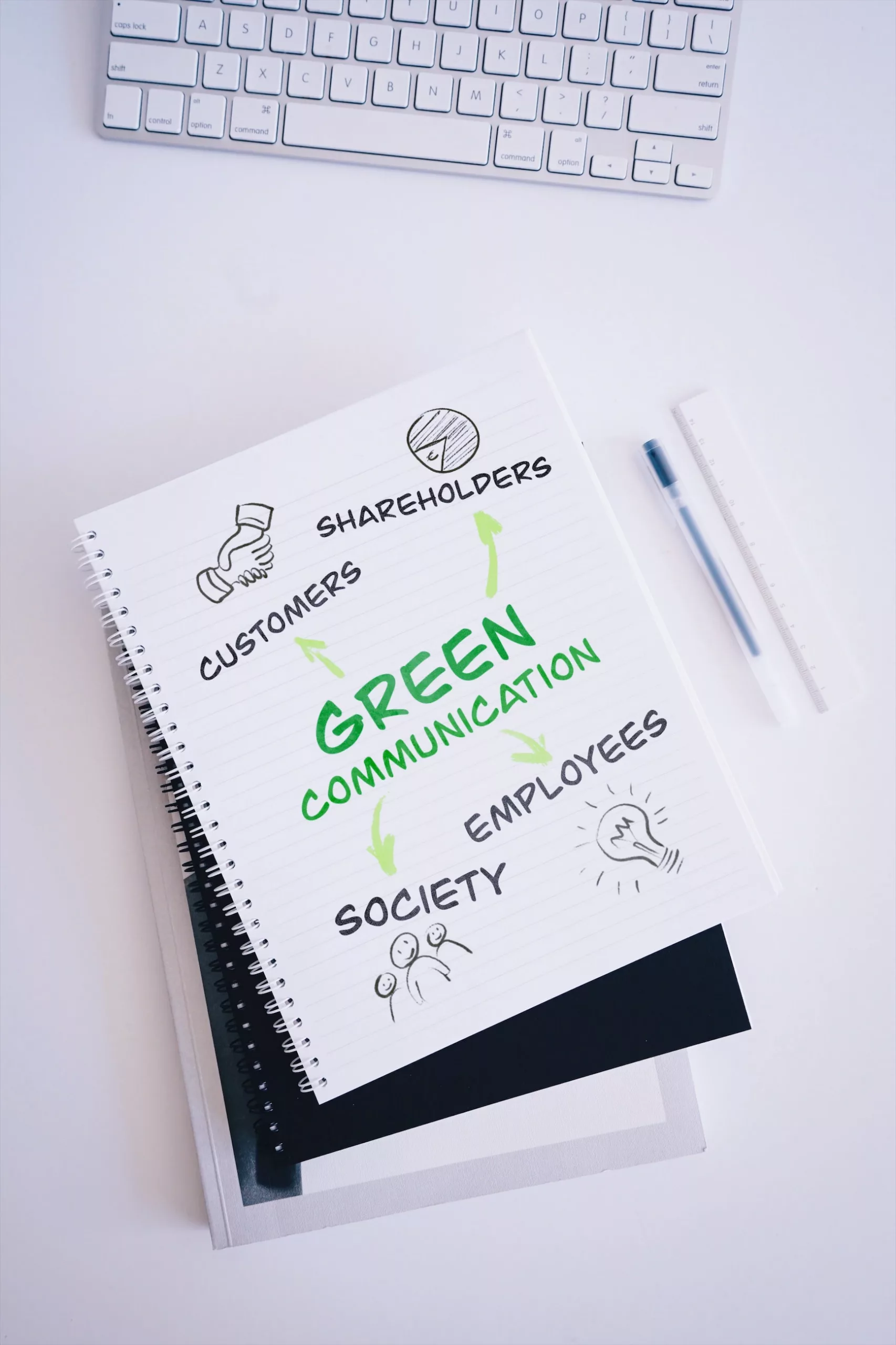INSIGHTS
by Anna Grochowska
The art of green communication
When communication goes green
We live in the information age. Our surroundings deliver us an enormous volume of facts, figures and opinions. Internet, our mailboxes, company servers seem overloaded with information. In such a context what can be the added value, for any green business, when it takes the trouble to start or keep communicating about its sustainable products and services?
The answer can be summed up in a popular saying: quality over quantity. Selecting meaningful information and turning it into useful messages for the public can strengthen the business and create positive impact in the environment and society. In this insight, we name this quality-oriented approach “green communication”, an art of conveying sustainability information that evokes understanding and meaning, gains trust and relevance and, while improving the business market presence, also contributes to its corporate environment.
Green communication is a means of conveying sustainability, which evokes understanding and meaning, and which is beneficial to both the business and its environment.
The origins of the definition
Analyzing the literature and present-day definitions around “green communication” can prove a challenge on its own. According to the Oxford English Dictionary, “communication” is “The transmission or exchange of information, knowledge, or ideas, by means of speech, writing, mechanical or electronic media”. As much as it can be a useful start, this vast definition seems to be missing out the non-verbal and visual forms of communication. Looking at the “green” adjective, on the other hand, according to the Collins dictionary, what should come to mind are the “issues and political movements (that) relate to or are concerned with the protection of the environment”. The latter term, environment, could relate both to nature, as well as the surroundings in which a business operates, including both its social and environmental aspects.
Upon deeper search, we also find a definition of “green marketing communication” which means the advertising efforts to convey environmental benefits of products and services. This definition seems to be limiting the activity entirely to the promotional aspects, leaving out the added value the communication can bring beyond just products and services publicity. In a similar context, we also encounter the term “green communication”, related to the informatics and telecommunications, which narrows the field to the IT domain, on which we reflect a bit later in the text.
Upon consideration, none of those modern definitions seem to be entirely exhaustive. We have therefore decided to go back to the fundamentals. What does the verb “communicate” mean? Its roots in the Latin language are « com » and “munis”, translating literally as “with the people”. Also, its two closely related words, “communion” and “community”, emphasize that key idea of bringing people together. This etymology investigation seems to convey an important meaning. The communication, especially a sustainable one, is in fact deeply related with people. In a complex, fast-pacing world filled with different technologies, successful green communication requires a genuine effort to take a human-centric approach and connect with individuals receiving our message.
Seeing all the different interpretations, we found it useful to create a working definition of our own. According to Vadviam, green communication is a means of conveying sustainability, which evokes understanding and meaning, and which is beneficial to both the business and its environment. As a practice, it fundamentally revolves around creating good relationships of enterprises with their partners, society and the environment. Successful green communications contribute to trust, solid reputation, and positive impact towards the enterprise and its ecosystem.

Composition by Vadviam
Green communication: a long-term effort, not a short-term fix
In face of climate challenges, many emerging technology startups are scaling up very fast. At the same time, in a market overwhelmed by information, often filled by skepticism for new, unproven solutions, traditional advertisement can lead to limited results. With the public increasingly aware of sustainability, all business communication remains under scrutiny.
Green communication can be a long-term approach to address this challenge. It involves a set of practices that relate to actual environment credentials, business ethics and corporate social responsibility. As a process, it is focused on creating positive impact both for the community and for the environment. It often requires more commitment on behalf of organization, however, the pay-off of such be substantial. Gaining trust between the enterprise and community, winning confidence of business stakeholders, and receiving much needed support for the new developed, innovative technologies, is a priceless reward for the energy spent on green communication.
With the public increasingly aware of sustainability, all business communication remains under scrutiny. Green communication can be a long-term approach to address this challenge.
This more meaningful form of informing about the enterprise and its products can be summarized in several features:
- purpose-driven: it stands in line with the core values of your business, so the conveying of message becomes an essential matter for the organization instead a mere cosmetic gloss;
- science and evidence based: it uses factual, scientifically sound and realistic messaging, which as much as possible, avoids ambiguity and space for misinterpretation;
- context-driven: it contextualizes the message, providing the purpose and meaning of the solution for the world, the business story, as well as complementary elements such as cultural background and history behind the technology;
- social-centered: being human-oriented, green communication focuses on initiatives that not only promote the environmental solutions, but also create positive social impact in the communities and engage the participation of people;
- responsible: it becomes a long-term strategy rather than a short-term fix for the enterprise, often being reflected in day-to-day activities of business;
- all-inclusive: it takes care of internal communication aspects to keep the business team and all partners informed, involved and engaged
Green communication which stands in line with features above can ripe many benefits for the companies who develop business sustainability or environmental products. However, involving all the practices requires navigating complex, often interrelated issues between enterprise and its surroundings. Because of this complexity, the field of sustainability communication, with its dynamic growth, have experienced many trials and errors. It can be a rich ground of both success stories, as well as unfortunate mistakes, of which we speak below.

Composition by Vadviam
Uses and abuses of green communication
The public relations and marketing activities, ironically, always seemed to be unable to entirely escape a bad image. As experts in dealing with public perception and emotions, the communication specialists can often be ridiculed as intriguers swilling gin and tonic, paid for oiling the wheels of power. Indeed, the market have seen many examples of deceptive practices, which we touch on in later paragraphs. However, increasing number of regulations and codes exist to help in navigating the communicating field in ethical way. Based on good practices, the green communication can be a heartbeat of value in organizations that are focused on well-being of their environment. Not only business entities, but also charities, governments and local associations use it daily, succeeding to convey their messages through and making positive contribution to the world around them.
Based on good practices, the green communication can be a heartbeat of value in organizations that are focused on well-being of their environment.
Below, we listed the principles that can help with that effort:
- putting emphasis on facts and avoiding the ambiguity. Principles of green communications are built on a thoughtful use of words to avoid unclear meanings behind the message;
- keeping the information short and understandable by removing non-essential words or long-winded sentences, to make sure the information is easy to comprehend;
- illustrating the message with relevant pictures, including images, graphs and charts in your green communication, to efficiently convey the principles behind technology and its impact;
- resorting to metaphors and figurative expressions to enrich the message and help in better relating to the solutions communicated;
- consideration given to the context, background and culture-specific topics help to frame the communication and support the readers in discovering the wider relationship of solution with its surrounding world (as an example, see our article: Energy Cultures)
Many times, drafting the green communication is outsourced to the external specialists, so the enterprise can focus on its core expertise in technology. Whether the business decides to build its own competence in communication, or outsource it to the advisors, we suggest complementing the communication skills with industry-specific, often technical knowledge, so the experts behind enterprise communication do not miss on the opportunity on grasping the intrinsic topics relevant to the new technologies.
Whether the business decides to build its own competence in communication, or outsource it to the advisors, we suggest complementing the communication skills with industry-specific, often technical knowledge.

Composition by Vadviam
Green communication vs. greenwashing – when sustainability messaging is in trouble
“They have commuted false report; moreover, they have
spoken untruths; secondarily, they are slanders; sixthly and
lastly; they have belied a lady; thirdly they have verified
unjust things; and to conclude, they are lying knaves”
– The idea of a bad communication, following Shakespeare’s Much Ado about Nothing, 1958
While the green communication can bring a big added value, an unfitting one can cause a great deal of damage to the business reputation. In this section, we go through the frequent slip-ups that may cause communications to be inappropriate.
- Unbalanced or out-of-context communication, which focuses on a specific set of solution advantages, but misses out on explaining eventual environmental or social trade-offs;
- Confusing information or poorly defined statements, which are likely to be misunderstood by the recipient, sparking debates and controversies around the technology;
- Misleading or unauthentic images, including presenting charts with distorted scales, or graphs that are overcrowded with information and difficult to read;
- Obsolete and cliched visuals, failing to represent the reality and bringing connotation to popular stock pictures or stereotypic images;
- Confused grammar, punctuation, jargon and euphemisms causing difficulty in reading, asking for extended effort to understand the meaning behind it;
Many of those points have common ground with ethical business communication rules, while others refer to fact-checking the message and maintaining its appropriate style. All together, they can reflect badly on the business reputation, undermine the trust towards product and slow down the market development.
While the green communication can bring a big added value, an unfitting one can cause a great deal of damage to the business reputation.
Communication going digital: the role of technology
Every day, millions of people are searching for information on the sustainability. In the context of fast developments in the information technology, computing and telecommunication, the digital forms of communication are often a predominant one. While engaging in efforts in this field, it’s also important to remember of the carbon footprint of our activities.
According to the Website Carbon Calculator, which allows to check the footprint of your individual site, the transmission networks of data centers and connected devices can have energy demand equal to or greater than the global aviation industry. The average web page tested produces approximately 0.5 grams CO2 per page view. For a website with 10,000 monthly page views, that amounts to 60 kg CO2 per year.
Following to the book “The carbon footprint of everything” by Mike Berners-Lee, a single email taking around three minutes to read, sent from a one laptop to another, can account to 17 g of CO2 emissions. A five-minute internet search, on the other hand, can reach 6.9 to 9.6 g of CO2 emissions.
However insignificant the numbers may seem in the overall context, these can provide interesting perspective to management of sustainability and keeping right focus while producing and publishing the new communications by environmentally conscious businesses.
The art of green communication
At Vadviam, we specialize in sustainability communication as well as environmental projects. The company was founded by Anna Grochowska, an engineer hailing from the sector of green technologies, and François Dauteuil, an expert in film and narrative art.
Drawing on our experience in the technical industry, combined with the art of storytelling, we communicate on the impact of corporate activities, while at the same time keeping their specifics and unique features at heart. Thanks to this, we help purpose-driven enterprises to improve their market presence as well as their social and environmental impact.
About us
Vadviam connects knowledge of environmental matters with a passion for social progress. By combining years of experience in industrial decarbonisation with novel approaches to articulating sustainability, we help companies to enhance and communicate their performance in this field.

